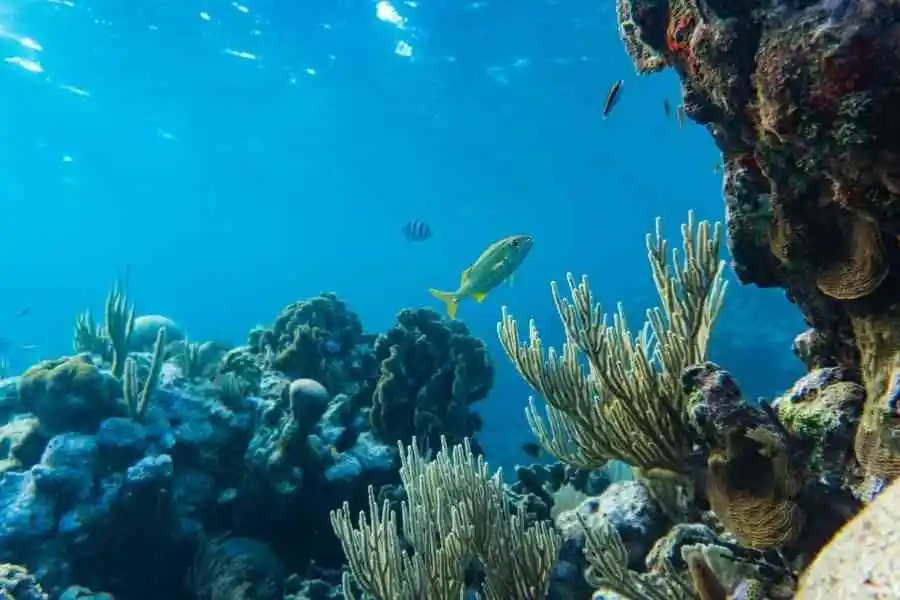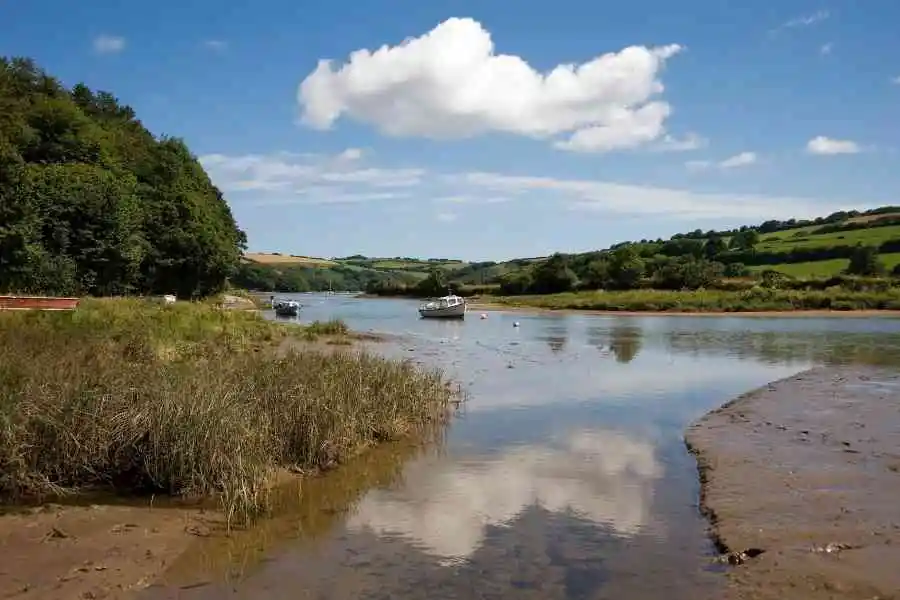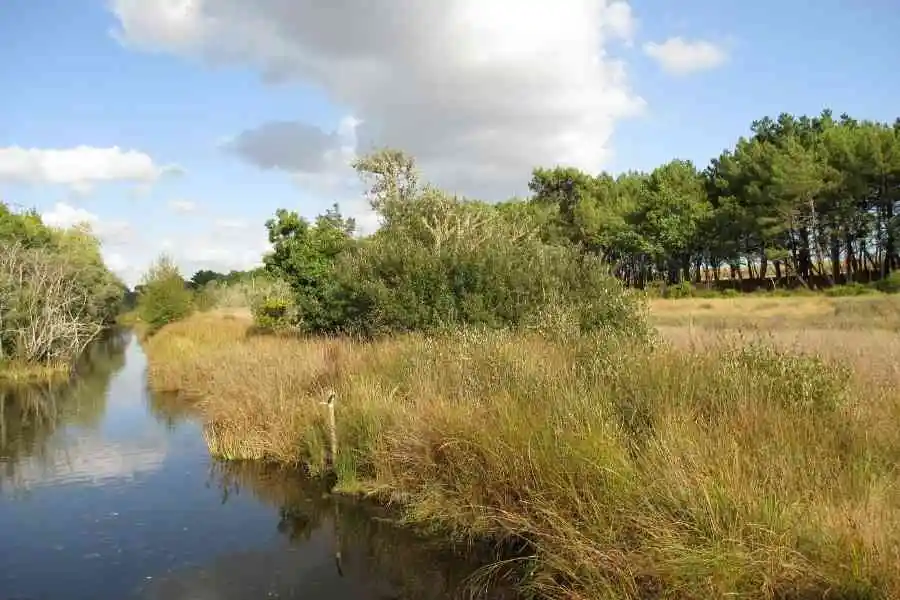The study of the relationship between coastal organisms and their surrounding environment is known as the coastal ecosystem.
What is Ocean?

The word ocean is derived from the Greek word “Okeanos”. The ocean is a major body of saline water and a principal component of the hydrosphere. Approximately 71% of the Earth’s surface (~3.61 × 1014 m2) is covered by the ocean, a continuous body of water customarily divided into several principal oceans and smaller seas. More than half of this area is over 3000 meters (9800 ft) deep. Average oceanic salinity is around 35 parts per thousand (ppt) (3.5%), and nearly all seawater has a salinity range of 30 to 38 ppt.
What is the coast?
The coast is defined as the part of the land adjoining or near the ocean or its saltwater arms. In simple words, the coast is the edge of the land where it meets the sea or ocean. A precise line called a coastline cannot be determined due to the process of tides.
The term coastal zone can be used instead of a spatial zone where the interaction of the sea and land processes occurs. Both the terms coast and coastal are often used to describe a geographic location or region, for example, New Zealand’s West Coast or the East and West Coasts of the United States.
Coastal ecosystem:
Coastal ecosystems are generated by plants and other animals that can thrive in saltwater and fluctuating tides. Like forests, many coastal habitats contain plants that regulate Earth’s temperature. As plants grow, they pull carbon from the air and store it in their tissue, roots, and soil. As carbon dioxide, it would trap heat and overheat the globe if released into the atmosphere.
Coastal Ecosystem Characteristics
Coastal habitats have biodiverse marine populations that vary by topography and climate. Bays, estuaries, mangroves, salt marshes, and wetlands are coastal ecosystems.
Many fish, turtles, and migratory birds nest in coastal locations because of the food and protection from the deep ocean. Human activities, natural disasters, and invading animals can disrupt these communities.
Coastal organisms thrive due to abundant sunlight and nutrition. Shallow coastal waters let sunlight reach the ocean floor, where dead organisms nourish life.
Sunlight can only reach 50 to 100 meters into the water, therefore nutrients sink too deep to support most living species.
Formation of coasts:

Coastal landforms are landforms along the coast. Erosion and deposition cause changes in coastal landforms. Climate, weather, water (waves, tides, currents), and gravity also affect coastal landforms.
Waves erode and deposit coastlines. Small waves can transport sand along the coast. Storm waves can carry big rocks to the deeper sea. Time changes the coastline’s shape.
The main agents responsible for the deposition and erosion along coastlines are:
Waves:
Waves erode the coastline as they break on shore, releasing their energy. The larger the wave, the more energy it releases and the more sediment it moves. Coastlines with longer shores have more room for the waves to disperse their energy, while coasts with cliffs and short shore faces give little room for the wave energy to be dispersed.
Tides:
Tides often determine the range over which sediment is deposited or ordered. Areas with high tidal ranges allow waves to reach farther up the shore, and areas with lower tidal ranges produce deposition at a smaller elevation interval. The tidal range is influenced by the size and shape of the coastline.
Currents:
Like waves and tides, the current itself plays a vital role in coast formation. The formation of coasts is also heavily influenced by their lithology. The harder the material, the less likely it is to erode. Variants in the rock create different-shaped coastlines.
Types of Coastal Ecosystem:
Simply we can define a coastal zone as a physical region extending from the edge of the continental shelf to the intertidal and near-shore terrestrial area; globally, this physical region includes a wide array of near-shore terrestrial, intertidal, benthic, and pelagic marine ecosystems. Xiaojun Yang (2008) classified coastal ecosystems into the following five major categories –
- Estuaries
- Coastal marshes
- Mangroves
- Seagrass system and
- Benthic system
Estuaries:

Estuaries are partially enclosed bodies of coastal waters typically found where fresh water from rivers meets saltwater from the ocean. As the tidal mouths of rivers, estuaries, and surrounding lands are a place of transition from land to sea. They are often known as bays, lagoons, harbors, or fjords. Estuaries are important ecosystems, providing goods and services that are ecologically, economically, and culturally indispensable.
Ecologically, estuaries are not only the nurseries of the sea, providing habitats for many marine organisms. Such as fish, mammals, birds, and other wildlife, but also serves as a natural buffer that filters out much of the sediments and pollutants carried in by terrestrial runoff, creating clearer water that eventually benefits both human and marine life. Economically, estuaries support significant fisheries, tourism, and other commercial activities and develop important public infrastructures, such as harbors and ports vital for shipping, transportation, and industry.
Culturally, estuaries are often the focal points for recreation, commerce, scientific research and education, and aesthetic enjoyment. The major threats to estuaries are from human activities, as more than two-thirds of the large global cities are based on estuaries. Stresses caused by excessive use of natural resources and unchecked watersheds and land-use practices have resulted in water quality degradation, harmful algal blooms, unproductive fisheries, loss of biodiversity, and many other health and natural resource problems.
Coastal marshes:

Coastal marshes are a sensitive, dynamic, and productive ecosystem. They are predominantly grasslands periodically flooded by tides in the intertidal regions. The salinity from salt or brackish tidal waters creates a salt-stressed aquatic environment where halophytic plants thrive. Coastal marshes may be classified as salt, brackish, and freshwater marshes.
Coastal marshes are of great ecological value because they serve as the nursery grounds for fish, habitats for a wide variety of wildlife, and buffer zones to protect water quality. The major disturbances and threats to coastal marshes largely come from human activities, such as draining, feeling, ditching, and waste dumping. However, natural processes like sea-level changes can also affect the aerial distribution of coastal marshes.
Mangroves:

The mangrove ecosystem is commonly found in tropical and subtropical tide lands worldwide. The mangrove family of plants dominates this coastal wetland ecosystem due to their ability to thrive in the saline coastal environment. The three mangrove species grown in the United States are red, black, and white mangroves. The term “mangrove” can narrowly refer to these species but most commonly refers to the habitat and entire plant assemblages, for which the term “mangrove swamp” or “mangrove forest” is often used. Because mangroves are constantly replenished with
nutrients, they sustain a huge population of organisms that feed fish and shrimp, which support a variety of wildlife. In addition, their physical stability helps to prevent shoreline erosion, shielding inland areas from damage during severe storms and waves. The major threats to mangroves are mostly related to human impacts from dredging, feeling and diking, oil spills, pesticides, herbicides, and urban waste runoff.
Seagrass system:

Seagrass are aquatic flowering plants that live fully submerged in the saline coastal environment and are also called “submerged aquatic vegetation”. Seagrasses can form extensive beds dominated by one or more species. They are distributed worldwide in soft sediments from mean low tidal level to the depth limit determined by the light penetration that permits seagrass plants to photosynthesize.
Seagrass beds are a highly diverse and productive ecosystem, and they almost always support more invertebrates and fish than the adjacent areas lacking seagrass. In addition, seagrass beds provide coastal zones with ecosystem goods and services such as fishing grounds. Wave protection, oxygen production, and protection against coastal erosion. Disturbances and threats to seagrasses include natural processes such as grazing, storms, and desiccation. Still, human activities such as eutrophication due to excessive nutrient imports, mechanical destruction of habitat, and overfishing are considered to be the major stressors.
Benthic system:
The benthic system is the community of organisms living on the bottom of the oceans in areas not colonized by macrophytes. Benthic habitats are Virtually bottom environments with distinct physical, chemical, and biological characteristics. They vary widely depending upon their location, depth, salinity, and sediments. Benthic habitats in areas with a depth of more than 200 m have been much less commonly observed.
Estuaries and near-shore benthic habitats can be highly diverse, including submerged mudflats, rippled and sandflats, rocky hard bottom habitats, shellfish beds, and coral reefs. In terms of ecological functioning, the benthic system serves as the site of nutrient regeneration and considerable secondary production utilized by important predators, such as bottom-feeding fish and crustaceans. The major disturbances and threats to the benthic systems are similar to those listed for seagrasses.
Carbon storage and coastal protection
Thicker, rich soil helps coastal ecosystems store carbon. Most dying trees emit carbon. In many coastal environments, dead plants’ carbon persists in waterlogged soils for millennia. Mangroves store 3-5% more carbon per acre than tropical forests. Coastal wetlands filter carbon-rich sediments from river water as it travels to the sea. Loss of coastal ecosystems drives climate change.
Coastal habitats protect against climate change. Hurricanes and other storms push water walls nearer shore. Coastal habitats lessen storm surges by absorbing wave energy. Sea level rise and bigger hurricanes will require this protection.
